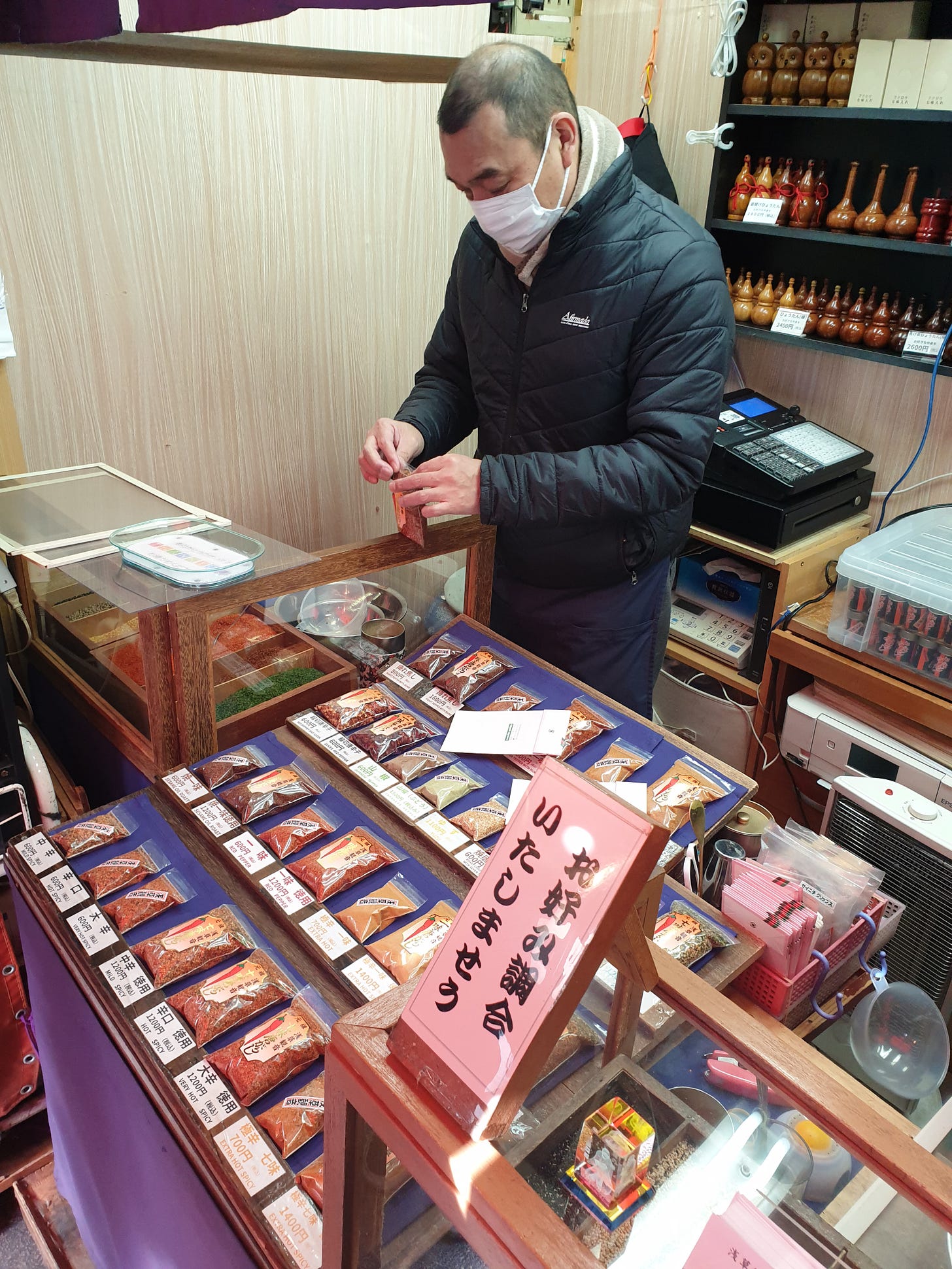Firstly, thankyou so much to all of you who engaged with last week’s post on the John Lewis Partnership - it very quickly became the most-read and most-shared thing I’ve written in a long time, and stimulated some fascinating discussions too.
I’m going to follow that train of thought next week with a piece on the pros and cons of different ownership structures for retail and hospitality businesses, including puncturing some of the myths that exist about them.
But for now, something completely different.
Take a look at the chap in the picture here. He sells 7-Spice, a classic Japanese spice mix used in all sorts of dishes. Each of those little packets in front of him is a slightly different version - some citrussy, some more spicy. But ask him for some, and the first question he’ll ask you is how you want your 7-Spice to taste. And then he or his wife make it for you, right in front of you, cheerfully scooping individual spices out of containers into a mixer and producing a product designed, live, just for you.
The theatre of that is amazing, as is the end product. Reflecting on it, though, puts me in mind of the second in our series of consumer megatrends. You’ll remember the first from a few weeks ago, on the power of delivering ‘experiences’ alongside just selling product.
“Experiential retail” when done well is a way of reframing the discussion with the customer away from “what’s your price for this product and how does it compare with everyone else’s?” to something richer and less vulnerable to comparisons.
Personalisation, then, can be viewed as another way of achieving the same goal. Indeed, if you can customise and tailor your product to the needs of an individual customer you are arguably taking the strongest possible step away from banal price competition. It is hard for me to price compare something you’ve made just for me.
And personalisation (or customisation) is not just the preserve of our 7-spice merchant - it turns up in all sorts of corners of the retail and hospitality sectors. Consider:
The paint mixing and colour-matching services many home retailers offer
The infinite variety of coffees you can make out of a choice of bean and of milk type
The process of ‘fitting’ golf clubs or road bikes to the needs of the individual customer.
The clothing retailer with the ability to tailor and alter garments for that perfect fit.
Each of these leaves the customer with a product which is, to at least some extent, unique to them and each of them involves a process of discussion and discovery which itself offers the vendor a great ability to build a relationship with their customers that is likely to drive repeat business. Indeed, the sharp-eyed reader will spot that personalisation and experience go hand-in-hand as retailer differentiators, since the experience of having a product tailored for you can be a really rewarding one for customers and vendors alike.
There is a powerful exercise we can all do as retailers, then, which is to consider how personalisation might work in our sectors. Don’t be too quick to conclude that it isn’t relevant to you because you sell pre-packaged third party products. As we’ve seen in our examples here there is a broad spectrum of personalisation from slight customisation to fully hand-crafted individual products and there may be somewhere on that spectrum that works for you.
Consider, for example, that more than one furniture retailer will now offer to cover your new sofa in literally any fabric you choose.
I’m surprised sometimes that more retailers don’t fully explore the ways that personalising or customising for their customers could change the competitive game for them. Look at the example I gave earlier about coffee retailers - it is amazing how many coffee shops just offer the same set of milk options and no choice of different coffee beans or roasts.
And continuing the coffee example, real personalisation is an effort of detail as well. I remember spending a week in a suburb of Seattle on a project. The first couple of days I got my breakfast in the same Starbucks (a cinnamon latte and a blueberry scone, if you must know) - and by day 3 they just made them for me when they saw me walk in. A massive chain Starbucks may be, but the crew in that particular outlet made every regular customer feel individual and special, in a way I’ve seen many cooler indie outlets fail to do.
So what might personalisation mean for you? Can you tailor your clothes offering to my fit? Can you print personalised things in store, or design something alongside me in your store and have it delivered to my home? Can I tailor colours, finishes or other details? Can you set up my technology product or my fitness equipment for me? Can you measure my walking or running gait to get me the perfect shoe? And if nothing else, can you just remember how I like my coffee?
Because if you can, you have a whole new way to compete. And don’t be afraid of using that service as a differentiator. Yes, there are many online marketplaces that will print a bespoke t-shirt or even put your chosen image on a rug, but the experience of receiving personal service and personalisation in a store from a well-informed and expert store colleague is yet another way that physical retail can still stand out.
P.S.
Moving Tribes hit the printed page this week as the lovely team at Furniture News published a version of a post you saw a couple of weeks ago here at Moving Tribes on the big retail question of Why Should I Buy From You. Have a look, and browse their excellent magazine if you are interested.


